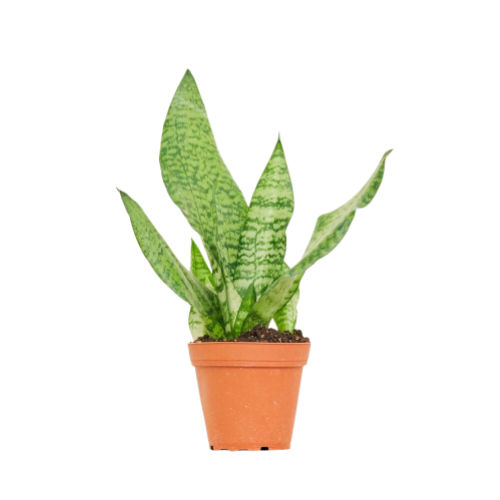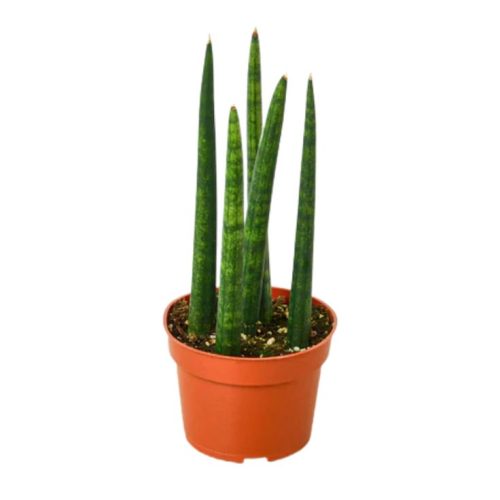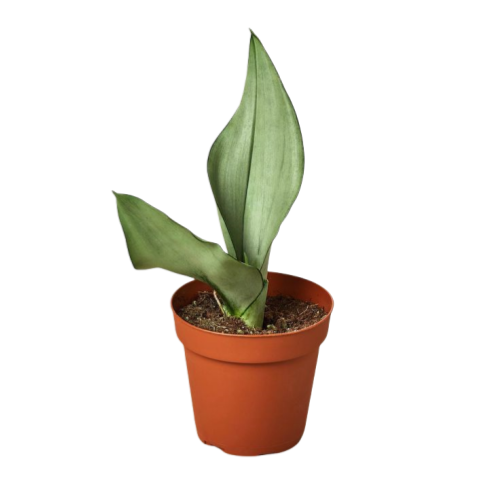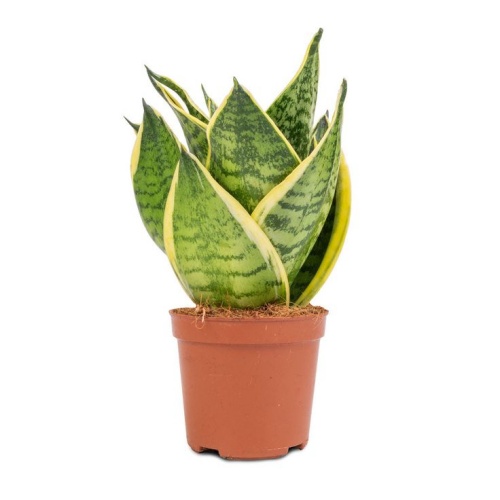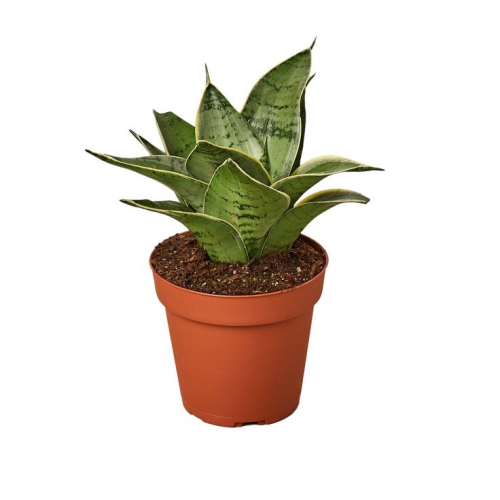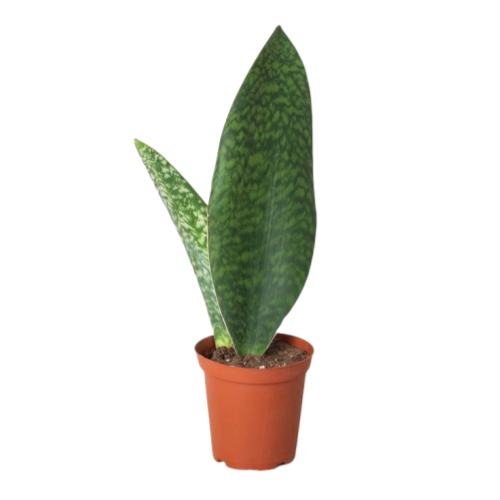Sansevierria La Rubia
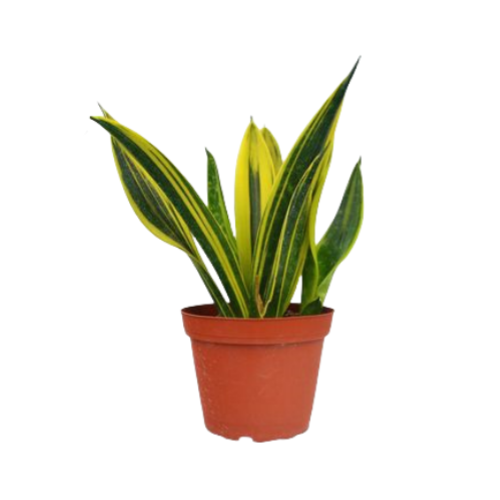
- Botanical Name: Sansevieria trifasciata ‘La Rubia’
- Family Name: Asparagoaeeae
- Jirdhiska: 2-5 Inch
- Heerkulka: 12 ℃~29℃
- Others: Bright indirect light, drought-tolerant.
Kudbad gaaban
Sharraxaadda Wax soo saarka
Tropical Stripes & Style: The Sansevieria La Rubia’s Low-Effort, High-Impact Greenery
The Striped Wonder: La Rubia’s Tropical Charm
Sansevieria La Rubia, scientifically known as Sansevieria trifasciata ‘La Rubia’, originates from the tropical regions of West Africa, ranging from eastern Nigeria to the Congo, and is also naturally found in Madagascar and India.
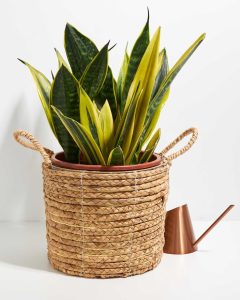
Sansevierria La Rubia
This plant is renowned for its striking yellow and dark green striped leaves. The sword-shaped leaves feature a unique combination of yellow and green, with each plant’s leaves exhibiting a distinctive color and stripe pattern, making each Sansevieria La Rubia truly one-of-a-kind. In terms of leaf morphology, they typically grow upright, forming a basal rosette, with long and narrow leaves. The edges are usually green, while the center of the leaves display silver-gray or yellow stripes, making Sansevierria La Rubia Istaag dhirta badan ee dhexdooda midabkeeda gaarka ah awgood iyo qaabkeeda.
The Low-Maintenance Diva: Sansevieria La Rubia’s Easygoing Green Lifestyle
-
Iftiin: Sansevierria Laupia ayaa doorbidaya iftiin dhalaalaya, oo aan toos ahayn oo laqabsan karo xaaladaha iftiinka hooseeya, laakiin nalka dhalaalaya ayaa ka caawiya joogtaynta midabkiisa caleentiisa. Iftiinka tooska ah ee qorraxda waa in laga fogaadaa maadaama ay dhalinayso caleemaha.
-
Biyo: Dhirtani waa mid aad u dulqaad badan, oo waraabintu waa inay dhacdaa ka dib markii ciiddu si buuxda u qalajiso. Iskucelcelis ahaan jawiga guriga, tani waxay la macno tahay in la waraabiyo 4 toddobaad kasta, laakiin inta jeer inta badan way kala duwanaan kartaa iyadoo kuxiran xilliga, deegaanka, iyo xaaladaha fudud. Waraabiyo isdaba joog ah ayaa loo baahan karaa inta lagu jiro bilooyin diiran.
-
Ciid: Waxay u baahan tahay carrada si fiican u dhajisa, sida kuwa loo isticmaalo cacti ama sumcadaha, si loo yareeyo xaaladaha koritaanka dabiiciga ah. Isku-darka ciid, perite, iyo arinta dabiiciga ah waxay ka caawisaa bixinta dheecaanka iyo nafaqooyinka lagama maarmaanka ah.
-
Heerkulka iyo huurka: Sansevieria La Rubia grows well in a temperature range of 60°F to 85°F (16°C to 29°C) and can tolerate low humidity. Waa xulasho ku habboon oo loogu talagalay jawiga hawada qallalan maadaama aysan u baahnayn qoyaan badan oo si ay u rogto.
-
Bacrinka: Apply a balanced liquid fertilizer every 4-6 weeks during the growing season (spring and summer). Reduce fertilization in the fall and winter when the plant’s growth slows down.
-
Goosashada iyo dayactirka: Sansevieria La Rubia requires minimal pruning. Remove any yellowing or damaged leaves to maintain the plant’s appearance and health. Repot every 2-3 years to refresh the soil and accommodate its growth.
Mas'uuliyiinta cagaaran: Dayactirka hoose, qaab-dhismeedka sare ee SANEVEVIERIINIA
SANSEVIERIA La Rubia iyo noocyadeedii dhirta ee la mid ah, sida SANSEVIEA Trifacaasica iyo Dahabka Hahnii, oo ka soo jeeda gobollada Galbeedka ee Afrika iyo qeybaha koonfureed ee Aasiya. Dhirtan waa kuwa la jecel yahay ee loogu talagalay wax-ku-oolnimada iyo kuwa dayactirka hooseeya. Waxay la qabsan karaan xaaladaha iftiinka iyo deegaanka ee kaladuwan, oo laga bilaabo iftiinka qorraxda ee aan tooska ahayn ee iftiinka hoose, oo ay leeyihiin baahiyo biyood oo yar, oo ah caleemo saafi ah, oo ah caleemaha ay ku keydiyaan biyaha, sida guuto badan.
These Sansevieria species are known for their unique aesthetic appeal. Their long, upright leaves range in color from green to nearly black, often adorned with distinctive patterns, such as the yellow edges of Short Leaf Sansevieria (Sansevieria trifasciata ‘Hahnii’) and the silver leaves of Silver Short Leaf Sansevieria (Sansevieria trifasciata ‘Laurentii’). The decorative appearance of these plants makes them a popular choice for indoor decoration.
Beyond their beauty, Sansevieria La Rubia and similar varieties are also favored for their air-purifying capabilities and oxygen release at night. NASA’s clean air studies have shown that these plants can filter toxins such as formaldehyde, benzene, and trichloroethylene, helping to improve indoor air quality. They release oxygen through photosynthesis at night, making them suitable for placement in bedrooms to support better sleep. These health benefits, coupled with their easy-care characteristics, make these plants an ideal choice for homes and offices.





